Root Maggots in Alaska Home Gardens
PMC-00330 View this publication in PDF form to print or download.
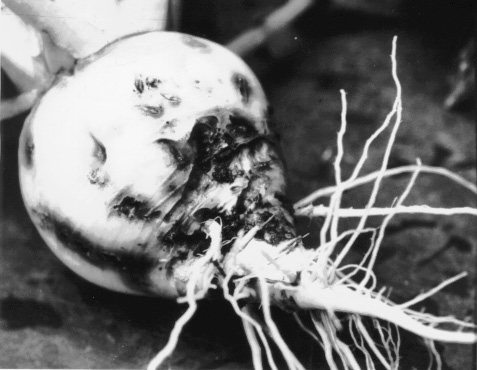
Root maggots are the most serious annually recurring insect pest problem of vegetable production in Alaska. They attack all varieties of crucifers. Most home gardeners are familiar with the damage caused by these insects. Successful vegetable growers make themselves aware of potential pest problems and plan a pest management strategy before planting their gardens. Integrated pest management (IPM) techniques and philosophy should be used in developing a pest management strategy.
When root maggot larvae feed on root crops such as turnip, rutabaga and radish, they leave surface scars and feeding tunnels (Figure 1). Any feeding scars may render the produce unacceptable for market, but the home gardener can trim off lightly damaged portions if the extent of damage is not too great. However, the root is often severely damaged. Feeding tunnels predispose the plant to infection by soft-rot bacteria and to secondary infestation by springtails and thrips.
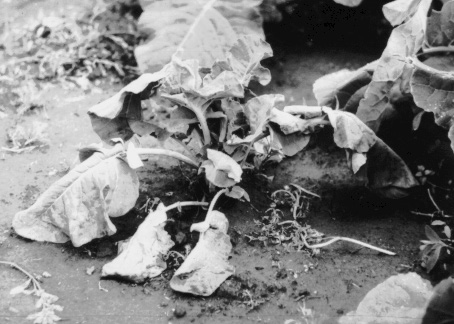
Feeding by root maggot larvae on the stem, leaf and flowering crucifers (cauliflower, broccoli, cabbage, Brussels sprouts and kohlrabi) results in slight to severe decline of the plants. The extent of the decline depends on the species of the host (Figure 2). Young plants may be girdled and die. Root systems on older plants may be extensively damaged and the taproot may be destroyed. In wet seasons, the damaged plants may be able to survive because of the production of adventitious roots, if there is a constant supply of water at the soil surface and cool air temperature. If plants survive, yield and quality are reduced. On warm days, the damaged root system cannot support the plant and the plant wilts. If days are warm and surface moisture is low, damaged plants may die.
To effectively deal with root maggots, it is necessary to have an understanding of their biology and seasonal activity. Root maggots are the immature stage, or larvae, of small flies that belong to the insect order Diptera (flies) and the family Anthomyiidae. Root maggots occur worldwide. They are short-lived insects (living for two to five weeks). The most serious root maggot pests in Alaska include the turnip maggot Delia (Hylemya) florali, seed corn maggot Delia (Hylemya) platura and the cabbage maggot Delia radicans. The turnip maggot and cabbage maggot are found throughout Alaska and feed on all varieties of crucifers.
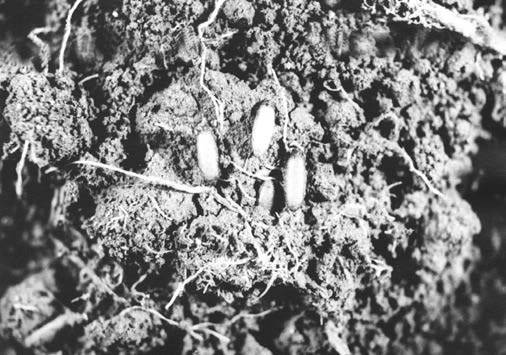
All species have basically the same life cycle. They overwinter as pupae (Figure 3) in the soil at a depth of one to five inches. As the soil warms in the spring, the root maggots complete pupal development and emerge as adults. The date of adult emergence varies from year to year and region to region, depending on the soil temperature regime, but occurs very early in the growing season. Emergence continues for four to eight weeks as the soil slowly warms at different depths. Following emergence, adults mate and lay eggs (Figure 5) at the bases of host plants at the soil surface, in cracks or under soil clods, or they may adhere to the plant stem. Egg laying begins two to seven days after the flies begin to emerge. Early in the season the flies appear to have a preference for larger plants, usually faster growing varieties. More than 100 eggs can be laid on a single plant over a period of two days. Eggs hatch in three to 10 days. The tiny first-stage larvae migrate down and tunnel into root tissue as they feed. In middle to late summer, when the larvae are mature (Figure 6), they move out of the root tissue and into the surrounding the soil to pupate. Usually only one generation matures each year.
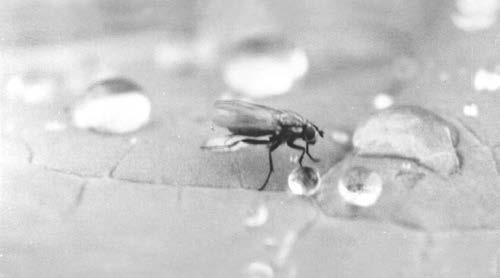
Root maggot adults lay eggs in the spring. Delaying planting root maggot-susceptible crops until the summer may allow the crops to avoid infestation by root maggots. Furthermore, varieties vary in susceptibility to root maggots. For example, red leaf cabbage is less susceptible to root maggots than green leaf cabbage.
CONTROL
Several techniques should be combined to provide the most complete protection against root maggots. Several cultural considerations should be considered in root maggot control. Root maggots thrive in organic matter, so organic gardening and soils high in organic matter can expect recurrent root maggot problems. The use of diatomaceous earth placed around the base of the seedlings will provide good control with no environmental hazards. Diatomaceous earth (a coarse sand-like particle) should be applied following each rain early in the season.
Crop rotation — Plant this year’s root maggot host plants in ground that did not have host plants in the previous year. The greater the separation between this year’s and last year’s crucifer plantings, the greater the effectiveness of this procedure. Crop rotation is often difficult in the home garden, but even a modest rotation and separation should be somewhat helpful.
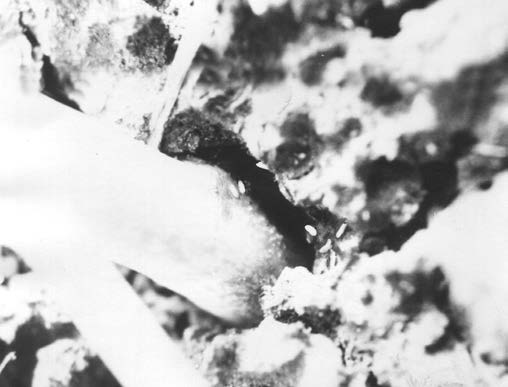
Sanitation — This is a very important procedure that can be done easily by the home gardener. Do not abandon root maggot infested crops. They harbor countless numbers of larvae, which, if allowed to mature, will be the source of next year’s infestation. If you have given up on a crop for any reason (root maggot infestation or weed competition, etc.), remove the crop and destroy it. As you harvest stem crucifers, remove the root system. This is especially important in earlier-maturing varieties. Keep the garden and adjacent areas free of weedy mustards and other host plants.
Protective Covering — Floating row covers, such as remay, can prevent or drastically reduce infestation by root maggot populations when placed over transplants or seedlings. Row covers are not effective if the area planted is already infested with root maggot populations. Care must be taken when using polyethylene tunnels to prevent high temperatures or condensation and resultant foliage disease. Flat waterproof discs (four to six inches in diameter) or cotton can be placed closely around the stem of transplants to act as a barrier to egg laying.
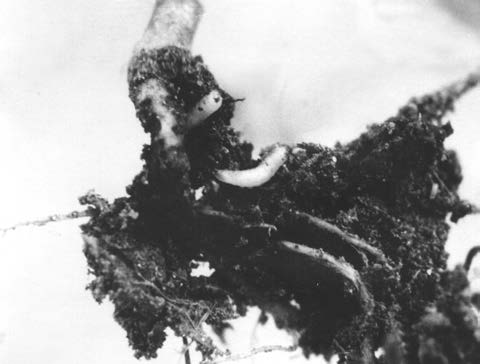
Biological Control — Beneficial nematodes (parasitic and entomopathogenic genera Heterorhabditis and Steinernemena) have proven to be effective in reducing root maggots when introduced annually. Enhanced natural populations of rove beetles (Aleochara sp.) also provide biological control of root maggots. The parasitic wasp, Trybliographa rapae, may provide control when maggots are close to the soil surface. Studies remain inconclusive on use of specific bacteria, such as Bacillus thuringiensis (Bt), to control root maggots. Use of biological control organisms requires careful handling and application and avoidance of most pesticides. Biological controls should be used in combination with other control strategies.
Pesticides — No pesticides are registered by U.S. Environmental Protection Agency (EPA) for use in home gardens to control root maggots in vegetables.
Any insect control strategy, including nonchemical and home remedies, should be based on facts about the biology of the pest and the principles of integrated pest management (IPM). Develop and implement an IPM root maggot strategy by following these steps:
- Know the pest's life cycle/habits and be able to identify its four life stages.
- Determine your strategy (most likely control, not eradication, of root maggots).
- Set an action threshold for root maggot population at which you will implement your control strategy.
- Preplan root maggot control actions from least harmful to people and the environment to potentially harmful.
- Regularly monitor your crops for root maggots.
IPM is cyclical, not linear. Regular monitoring for root maggots leads to positive identification of the insect and implementation of a control strategy as warranted, which leads to monitoring and evaluation of the control.
Spend time in your garden and know exactly what is happening there. Become familiar with the biology and seasonal cycles of insect pests so that you can understand why some methods of control work and others do not. Use facts and common sense and plan ahead.
To simplify information, trade names of products have been used. No endorsement of named products by the University of Alaska Fairbanks Cooperative Extension Service is intended, nor is criticism implied of similar products that are not mentioned.
Stephen Brown, Extension Faculty, Agriculture and Horticulture. Originally written by David P. Bleicher, Entomology Research
Technician, University of Alaska Fairbanks, Agricultural Experiment Station.
Reviewed March 2022
